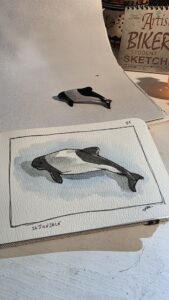
Panda Dolphin: Four feet long, fast as lightning, and dressed like a sea-going panda!
Sketch and Coffee Live at 5:30am Texas time
Today’s sketch was a four-foot, black-and-white blur of cold-water energy, the Commerson’s dolphin. The gremlins were thick at the start of the stream, but once things settled, I got into the flow. The toy reference came from a SeaWorld gift shop, and I found out it represents a species that’s so specialized, you’ll rarely find one in captivity. These little guys aren’t built for warm water tanks, they need frigid currents and wide-open space. I tried to keep the sketch honest, but I may have given this one a little extra chunk. Artistic license, right?
Scientifically, Commerson’s dolphins are part of the Cephalorhynchus genus, meaning “head-snout”, a nod to their blunt little faces. Unlike their orca cousins, who wear their black and white, these dolphins are white-bodied with jet-black heads and flippers. Their two populations, one off the coast of Chile, the other near the Kerguelen Islands in the Indian Ocean, have been isolated for about 20,000 years, ever since warm ocean bands separated their frigid habitats after the last ice age. Genetic studies using mitochondrial DNA show they likely split from the main dolphin lineage around 10 to 15 million years ago. They’re fast, agile, and possibly smart enough to recognize each other by the patterns of their markings.
Despite their rarity, Commerson’s dolphins are no longer considered endangered. They’ve been upgraded to “vulnerable,” but not due to conservation miracles. We just got better at counting them. They’re protected under Chilean and French laws, with dolphin-safe nets required in fishing, as as protected No-Fishing zones. Unlike many of their cousins, Commerson’s dolphins aren’t hunted, not even on porpoise. But warming waters still threaten their cold coastal homes. They’re not show animals. They’re not food. They’re just quietly remarkable and worth the effort to preserve.

Leave a Reply